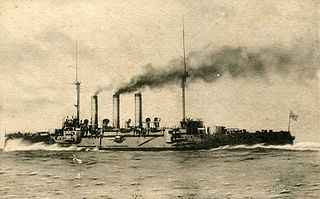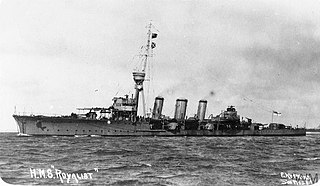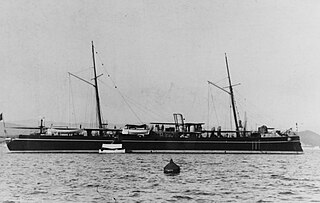
Zhenyuan was an ironclad battleship built for the Chinese Beiyang Fleet. She was the second and final member of the Dingyuan class, which included one other vessel, Dingyuan, both of which were built in Germany in the early 1880s. Delivery of the two ironclads was delayed by the Sino-French War of 1884–1885. The ships were armed with a main battery of four 12 in (305 mm) guns in a pair of gun turrets, making them the most powerful warships in East Asian waters at the time.

Dingyuan was an ironclad battleship and the flagship of the Chinese Beiyang Fleet. She was the lead ship of the Dingyuan class, which included one other vessel, Zhenyuan, both of which were built in Germany in the early 1880s. Delivery of the two ironclads was delayed by the Sino-French War of 1884–1885. The ships were armed with a main battery of four 12 in (305 mm) guns in a pair of gun turrets, making them the most powerful warships in East Asian waters at the time.

Chaoyong was a cruiser built for the Imperial Chinese Navy. She was built by Charles Mitchell & Company in Newcastle Upon Tyne, England, from a design by Sir George Wightwick Rendel which had already been used on the Chilean Navy vessel Arturo Prat. Two ships were ordered by the Chinese, Chaoyong and Yangwei. Both would serve together throughout their careers, assigned to the Beiyang Fleet and based in Taku during the summer, and Chemulpo, Korea, in the winter.

Yashima was a Fuji-class pre-dreadnought battleship built for the Imperial Japanese Navy (IJN) in the 1890s. As Japan lacked the industrial capacity to construct such vessels, the ship was designed and built in the United Kingdom. She participated in the early stages of the Russo-Japanese War of 1904–1905, including the Battle of Port Arthur on the second day of the war. Yashima was involved in subsequent operations until she struck two mines off Port Arthur in May 1904. The ship did not sink immediately, but capsized while under tow later that day. The Japanese were able to keep her loss a secret from the Russians for over a year. As a result, the Russians were unable to take advantage of the ship's loss.

The Izumo-class cruisers were a pair of armored cruisers built for the Imperial Japanese Navy (IJN) in the late 1890s. As Japan lacked the industrial capacity to build such warships herself, the vessels were built in Britain. They were part of the "Six-Six Fleet" expansion program that began after the defeat of China during the First Sino-Japanese War of 1894–1895. The sister ships participated in three of the four main naval battles of the Russo-Japanese War of 1904–1905—the Battle of Port Arthur, the Battle off Ulsan and the Battle of Tsushima—but played a much more minor role in World War I.

Jiyuan, was a protected cruiser of the Imperial Chinese Navy, assigned to the Beiyang Fleet. She was constructed in Germany as China lacked the industrial facilities needed to build them at the time. Jiyuan was originally intended to be the third ironclad battleship of the Dingyuan class, but was reduced in size due to funding issues. Upon completion, she was prevented from sailing to China during the Sino-French War.

HMS Royalist was one of eight Arethusa-class light cruisers built for the Royal Navy in the 1910s. She fought in the First World War, participating in the Battle of Jutland. Following the war, she was scrapped.

HMS Penelope was one of eight Arethusa-class light cruisers built for the Royal Navy in the 1910s. She fought in the First World War, following the war, she was scrapped.

The Centurion-class battleships were a pair of pre-dreadnought battleships built for the Royal Navy in the 1890s. They were rated as second-class battleships because they were less heavily armed and armoured than the first-class battleships. They were designed for service abroad and were given higher speed and longer range to counter the armoured cruisers then being built as commerce raiders.

HMS Centurion was the lead ship of her class of two pre-dreadnought battleships built for the Royal Navy in the 1890s. Intended for service abroad, they exchanged heavy armour and a powerful armament for high speed and long range to counter the foreign armoured cruisers then being built as commerce raiders and were rated as second-class battleships.

Hai Chi was a Hai Chi-class protected cruiser of the Imperial Chinese Navy. She was at the time the largest warship in Imperial China with a displacement of 4,300 tons and was armed with two 8-inch (203 mm) guns and a top speed of 24 knots. She subsequently served in the Republic of China Navy, before being scuttled in 1937. The hull of the vessel was raised in 1960 and subsequently broken up.

The Topaze-class cruisers were a quartet of third-class protected cruisers built for the Royal Navy in the first decade of the 20th century. HMS Amethyst of this class was the first warship larger than a destroyer to be powered by turbine engines.

The Dingyuan class consisted of a pair of ironclad warships—Dingyuan and Zhenyuan—built for the Imperial Chinese Navy in the 1880s. They were the first ships of that size to be built for the Chinese Navy, having been constructed by Stettiner Vulcan AG in Germany. Originally expected to be a class of 12 ships, before being reduced to three and then two, with Jiyuan was reduced in size to that of a protected cruiser.

Stromboli was a protected cruiser of the Italian Regia Marina built in the 1880s. She was the second member of the Etna class, which included three sister ships. She was named for the volcanic island of Stromboli, and was armed with a main battery of two 254 mm (10 in) and a secondary battery of six 152 mm (6 in) guns, and could steam at a speed of around 17 knots. Her career was relatively uneventful; the only significant action in which she took part was the campaign against the Boxer Uprising in China in 1900. She returned to Italy in 1901 and spent the rest of her career in reserve or as an ammunition ship, apart from a brief stint in active service in 1904. Stromboli was stricken from the naval register in 1907 and sold for scrapping in 1911.

Vesuvio was a protected cruiser of the Italian Regia Marina built in the 1880s. She was the third member of the Etna class, which included three sister ships. Named for the volcano Mount Vesuvius, the ship's keel was laid down in July 1883. She was launched in March 1886 and was commissioned into the fleet in March 1888. She was armed with a main battery of two 254 mm (10 in) and a secondary battery of six 152 mm (6 in) guns, and could steam at a speed of around 17 knots. Her career was relatively uneventful; the only significant action in which she took part was the campaign against the Boxer Uprising in China in 1900. She was stricken from the naval register in May 1911 and sold for scrap in 1915.

Ettore Fieramosca was a protected cruiser of the Italian Regia Marina built in the 1880s. She was the fourth and final member of the Etna class, which included three sister ships of slightly smaller dimensions. Named for the condottiero of the same name, she was the only member of her class not named for a volcano. The ship was laid down in December 1885, launched in August 1888, and was commissioned in November 1889. She was armed with a main battery of two 254 mm (10 in) and a secondary battery of six 152 mm (6 in) guns, and could steam at a speed of around 17 knots.

Goito was a torpedo cruiser built for the Italian Regia Marina in the 1880s. She was the lead ship of the Goito class, which included three other vessels. Goito was built by the Regio Cantiere di Castellammare di Stabia shipyard between September 1885 and February 1888. She was armed with a variety of light guns and five 14-inch (356 mm) torpedo tubes, and was capable of a top speed of 18 knots. The ship served the duration of her career in the main Italian fleet. Her early service was primarily occupied with training exercises; front-line duties ended in 1897 when she was converted into a minelayer, though she continued to participate in fleet exercises. During World War I, Goito laid defensive minefields in the Adriatic Sea. She was eventually sold for scrap in 1920 and broken up.

Monzambano was a torpedo cruiser of the Goito class built for the Italian Regia Marina in the 1880s. The ship was built at the Arsenale di La Spezia, beginning with her keel laying in August 1885 and ending with her completion in August 1889. She was armed with a variety of light guns and five 14-inch (356 mm) torpedo tubes, and was capable of a top speed of 18 knots. The ship spent her career in the main Italian fleet conducting training exercises, and did not see action. She spent 1898 patrolling the eastern Mediterranean Sea with the Levant Squadron. Monzambano was withdrawn from service in 1901 and broken up for scrap that year.

Confienza was the last of four Goito-class torpedo cruisers built for the Italian Regia Marina in the 1880s. She was armed with a variety of light guns and five 14-inch (356 mm) torpedo tubes, and was capable of a top speed of 17 knots. The ship was built in the late 1880s, with her keel laying in September 1887 at the Arsenale di La Spezia; she was completed in April 1890 and thereafter entered service with the Italian fleet. Confienza had a short and uneventful career; she spent her time in Italian waters and did not see any action. Stricken from the naval register in August 1901, she was thereafter broken up for scrap.

The Goito class was a group of four torpedo cruisers built for the Italian Regia Marina in the 1880s. The members of the class were Goito, Montebello, Monzambano, and Confienza. They were among the first torpedo cruisers built for the Italian fleet, and were built to improve on the previous vessel, Tripoli. Experimental ships, the four Goito-class vessels varied in their dimensions, machinery, and armament, though all were comparable in terms of capabilities, having a top speed of 17 to 18 knots and carrying an armament of four or five 14-inch (360 mm) torpedo tubes.


















